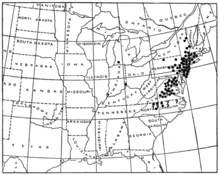2号群
2号群(Brood II),俗称东岸群(East Coast brood),是定期于美国东北部出现的15群周期蝉之一。个体身长约4公分,成虫活跃时间约两周,密度高达每公顷100万只。每隔17年,牠们会在数周内集体羽化、聚集、产卵并死亡。[1]

历史
编辑最早有关2号群的纪录,出自美国第三任总统汤马斯·杰弗逊在1775年的记载。他提及1724、1741、1758与1775年的2号群大发生。1775年,数以万计的周期蝉从杰弗逊的住所蒙蒂塞洛破土而出。[2]
2号群最后一次出现于2013年春末和夏季,预计将于2030年和2047年再次出现。[3]
相关
编辑参考文献
编辑- ^ Susan L. Post. A Trill of a Lifetime. University of Illinois. 2004 [October 12, 2013]. (原始内容存档于2012-05-11).
- ^ Jefferson, Thomas. Betts, Edward Morris , 编. Thomas Jefferson's garden book, 1766-1824, with relevant extracts from his other writings. Memoirs of the American Philosophical Society (Philadelphia: American Philosophical Society (1944)). 1775, 22: 68 [2017-05-20]. LCCN 45001776. OCLC 602659598 –通过Google Books.
Dr. Walker sais he remembers that the years 1724 and 1741 were great locust years. we all remember that 1758 was and now they are come again this year of 1775. it appears that they come periodically from the ground once in 17 years. they come out of the ground from a prodigious depth. it is thought they eat nothing while in this state, laying their eggs in the small twigs of trees seems to be their only business. The females make a noise well known. The males are silent.
- ^ Brood II. Cicada Mania. 2013-02-16 [2013-04-08]. (原始内容存档于2010-12-23).
- ^ Cicada Tracker | Radiolab. Project.wnyc.org. [2013-04-08]. (原始内容存档于2021-01-22).
- ^ Citizen Science: Cicada Watch. 17 April 2013 [24 April 2013]. (原始内容存档于2013-06-18).